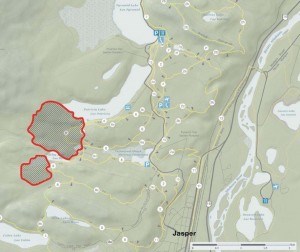
Parks Canada is putting its mountain pine beetle management plan into action. Starting this autumn, Parks will carry out a series of prescribed burns immediately west of town on the bench and near the east gate.
“You don’t have to look far to see that the mountain pine beetle has already taken off here and if we get a winter like we did last year then we can certainly expect that trend to continue,” said Dave Smith, a fire and vegetation specialist with Parks Canada.
“With that in mind we have to start thinking about how we’re going to protect this community—not so much from the beetle, but the fire that the beetle could cause.”
The beetles work by burrowing into pine trees and mining the phloem, the layer between the bark and wood of the tree, killing the tree and creating plenty of dry fuel for potential wildfires.
“If the beetle was just killing the trees that would be fine, but when the trees die they become much more of a fire risk than normal trees,” Smith said. “The whole reason we do these burns is to protect the community.”
In its recent mountain pine beetle management plan—which was released in August—Parks indicated that in 2015 the beetle colonized approximately 21,500 hectares of forest in Jasper National Park, more than three times the amount than in 2014.
“We’re really trying to get a move on this plan,” Smith said. “Basically we want to kill the trees before the beetle does.”
The burns near town will take place before the end of October. However, because of recent wet weather, Smith said it’s difficult to set an exact date.
“We haven’t had the best weather, but we’re optimistic and we’re prepared so once we get those nice dry fall days that we usually get then we’ll be able to push the go button,” Smith said.
As Parks gets ready to set the nearby forest ablaze, Smith said staff will be taking the most extreme safety precautions.
“We have to keep in mind that we’ll be burning close to people’s backyards. People will see smoke, but we want to assure residents that we won’t be taking any chances,” Smith said. “We have extra crews, we have lookouts and we’ll be able to shut down the fire as soon as we have to.
“We’ll be taking this in baby steps.”
Aside from the extra manpower, Smith said Parks has spent the last month fire-guarding the area, which includes cutting down trees and installing sprinklers.
“Essentially we’re creating a fire curtain around the whole area,” Smith said. “And the great thing about this area is that we’re already surrounded by water.”
For the burns, Parks will also install a series of artificial lakes, using 15,000-gallon pools called “pumpkins.”
After the burns at the bench, Parks will move on to the “Fiddle Unit,” burning trees in the valley between Highway 16, Fiddle River and the Athabasca River.
“Here we already have a great water system,” Smith said. “We have the highway which acts as a great fireguard and then we have the two rivers.”
In both areas Smith said Parks is hoping the burns will kill about 70 per cent of the trees.
“The most susceptible pine to mountain pine beetles are the ones that are over 80-years-old, which most of them are around here because we’ve suppressed fire,” Smith said. “We’ve created an unnatural setting and now Mother Nature has resorted to plan b, which is the pine beetle.”
According to Smith, burns allow the forest to recycle its nutrients and create new growth. Naturally most pine trees are recycled every 90 years due to natural elements like forest fires, however, because of human interference within JNP, Mother Nature has been unable to run its course.
“We’ve created forests that are unhealthy and now we have to live with that,” Smith said. “The ecological benefits of a burn are a given.”
Smith also said that Parks will continue prescribed burns in JNP throughout the winter and into the spring.
“We have an aggressive itinerary planned and whatever we can do in the winter we’ll do and whatever can’t be done will be pushed to the spring,” Smith said. “Nobody has been able to stop the pine beetle yet, but we’re remaining optimistic.”
Aside from prescribed burns, Parks’ beetle management plan includes other strategies to slow the spread of the beetle, which includes cutting down trees and using harvesting equipment to eliminate larger patches of infected forest.
Kayla Byrne
[email protected]
